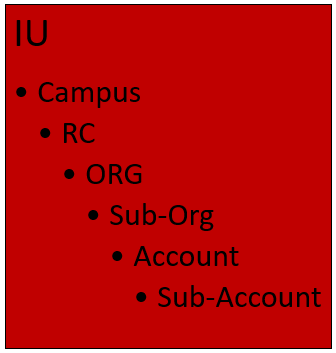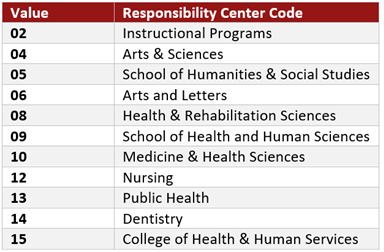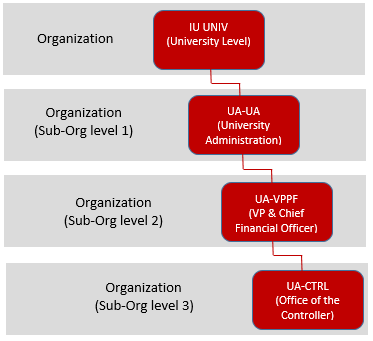Prerequisites
Prior to reading the standard on Chart of Accounts – RC, Org & Account it is beneficial to review the below sections to gain foundational information:
Preface
This standard discusses attributes of the chart of accounts including responsibility center codes (RC), organization codes (Org) and accounts, and how they impact accounting and financial reporting at Indiana University. The information presented below will walk through a general understanding of RC codes, org codes and the available accounts and sub-accounts within IU. The intent of this document is to provide a high-level overview of these chart attributes. The functionality and appropriate usage of the codes and accounts will be discussed in other sections of the IU Accounting Standards Book.
Introduction
Indiana University is a multi-billion dollar institution with a complex and diverse financial reporting system. The chart of accounts structure is used extensively to meet internal and external reporting needs. It provides units with a means of tracking and reviewing transactional data to ensure fiscal compliance with reporting standards, budget adherence and accurate financial reporting. By creating a chart of accounts structure, the user is provided with a variety of ways to summarize financial data ranging from a high level overview at the responsibility center level down to the most detailed level of sub-accounts within a unit.
Responsibility centers are units within the campus hierarchy to which executive management has delegated management authority. For academic units, a responsibility center generally corresponds to a college or school. For administrative units, a responsibility center is a collection of related support service organizations. Each responsibility center is unique and has its own organizational structure. Organizations are a collection of accounts and/or other organizations that form a hierarchy, starting with the university as a whole at the top and moving down through campuses, schools, and departments. Each organization reports to another organization that then reports to a responsibility center. Account numbers organize and catalog financial data and transactions at IU for a single activity. All financial transactions must have an account number, object code and dollar amount.

These attributes provide a foundation for management at all levels to facilitate internal and external financial reporting and analysis. The use of RC, orgs, accounts & sub-accounts within IU’s chart of accounts allows the financial users both internally and externally to easily evaluate the financial well-being of the institution as a whole down to a more granular account level as shown in the chart hierarchy above. Users can determine the appropriate level needed for analyzing and reporting financial data. This allows users to better understand their entity’s financial stability which is pertinent for internal and external reporting and compliance.
Importance and Impact Section
IU is a large and evolving organization with many accounting complexities, which is why the chart of accounts is critical to accurate and transparent reporting. This reporting hierarchy is an important tool used to determine appropriate allocation and use of funds from units, as well as for planning and budgeting purposes. These attributes ensure compliance with applicable reporting standards, adherence to allocated budgets, and stewardship of IU resources. Categorizing financial data also allows users to understand the nature of the activity at a glance. In addition, by grouping financial data at various organizational levels, users can more precisely review the financial health of the university ensuring greater financial integrity.
Lastly, these attributes are key in external financial, sponsored research, financial aid and tax reporting, among others. For example, improperly categorizing IU’s financial transactions impacts both reporting and tax filings resulting in potential fines, audit findings and future funding. Correct reporting is relied upon by executive management to make important decisions regarding the financial health of individual units.
Indiana University’s Responsibility Center Organizational Hierarchy
Responsibility Center Codes
Responsibility centers represent various colleges or administrative centers within the university. Each responsibility center is specific to a chart of accounts code within the campus. While there are more than 100 responsibility center codes in combination with chart codes, some examples of RC codes are listed below.

Each responsibility center has an identifying code (04-Arts & Sciences) and description (ARSC-Arts & Sciences) which is then associated with organizations to indicate where responsibility for that organization resides. While an RC is an attribute of an account, the organization (org) code is an important attribute of an RC. If there is an RC associated with an organization, it is denoted with an "R" as the last letter of the org code (i.e. MAIN LIBRARY DINING – BA-MNDR). To inquire on a responsibility center code at IU, refer to the Responsibility Center Lookup.
Within a responsibility center, the organizational structure can be many levels deep. Reports can be run at the responsibility center level for a high-level financial overview.
Organization Codes
Organization codes define units at many different levels within the university and allow users to further drill down to find more precise financial information. They are a collection of accounts or a collection of other organizations known as sub-organizations. The below diagram is an example of the Office of the University Controller presented within the organizational hierarchy.

Structurally, organization codes can include all fund groups and up to four alphanumeric characters (i.e. CTRL), but may have less. There are hundreds of organization codes within the university. A few examples are listed below.
- BOWN – Bowen Research Center
- RCOM – Research Compliance
- REL – Religious Studies
- WEDR – Wells Library Dining
For a full detail of the available organization codes at IU, refer to the Organization Code listing.
In general, an organization may have any of the following attributes:
- Chart of Accounts
- Responsibility Center
- Campus
- Department
- HRMS
Account Numbers
An account number is an identifier for a given pool of funds that represent a specific activity or purpose. Accounts store information about financial transactions; they describe the purpose of and who is making a transaction. All accounts at IU are self-balancing and include both balance sheet and income statement object codes. Accounts are seven digits, unique, and chart-specific. Some accounts have specific start and end dates, such as grant accounts. Other accounts exist for an unlimited time, such as a department's general fund account. Account numbers are organized into fund groups, which are further divided into sub-fund groups. Fund groups can be identified by the account number prefix. The table below identifies the associated fund group by the prefix of an account.
| Account Prefix | Fund Group | Fund Group Code | Short Description of Fund Group |
|---|---|---|---|
| 03-19 | General Fund | GF | Expense-driven, base-budgeted accounts used for daily operating expenses (e.g., office supplies, payroll, etc.) and funded by tuition, fee and state appropriations. |
| 11, 20-24 | Designated Funds | DS | Funds set aside by the university for a specific purpose or function. |
| 25-29 | Restricted Funds | RF | Funds provided from an external source, often as a gift, with restrictions on how the funds may be used. |
| 40-59 | Contract and Grant Funds | CG | Each restricted account represents a specific contract or grant. These funds are administered through the Office of Research Administration. |
| 60-66 | Auxiliary Enterprises | AE | Accounts linked to revenue-generating activities that provide a good or service that does not directly support IU's mission. |
| 68 | Clearing Funds | CL | These accounts are used as a temporary placeholder until the correct account classification for a transaction is determined and cleared within 30 days. |
| 70 | Loan Funds | LF | Funds held by the university for the purpose of making loans to students. This includes campus based and short term loans. Both loan types are administered by the University Loan and Collections Services or through the Bursar. |
| 80-85 | Endowment Funds | EN | Gifts to IU, or funds designated by IU, that have been restricted to the extent that only income derived from the investment of gift principal may be expended. These accounts do not include endowment received and held by the Indiana University Foundation. Endowment fund accounts are managed centrally by the University Office of the Treasurer. |
| 90-95 | Plant Funds | PF | This fund group contains university capital assets and related activity. Renewal and replacement accounts that cover the cost of repairs and replacements, retirement of indebtedness accounts for payment of debt obligations, construction and major remodeling accounts for capital improvements, and major maintenance of physical facilities. |
| 96-98 | Agency Funds | AF | Funds held for others for which IU acts as custodian or fiscal agent on behalf of the university. |
| 99 | Other Funds | OF | Used by Treasury to record investments that are distributed to operating accounts. |
For further information on this topic, refer to the Fund and Sub-Fund Groups document.
Sub-Account Numbers
Sub-accounts achieve further division of an account for internal reporting purposes and allow for tracking of financial activity within a particular account at a finer level of detail. Instead of associating budget, actuals and encumbrances with an account, a sub-account can be specified within that account to apply these entries. Sub-accounts are often used to help track expenses when several different activities may be funded by the same account. For example, a large organization may have money in a general account that is used by several different areas of that organization. The organization might segregate the budgets for each of the areas into sub-accounts such as Marketing, Research, and Recruitment. When expenses are applied to the account they can be applied to the sub-account level, allowing direct comparisons between the budget and the actual income and expenditures of these smaller categories. Because all of the activity is still within a single account, it is still easy to report on the finances of the overall account.
Structurally, sub-accounts are account specific, can include up to five alphanumeric digits and assumes all attributes of the account to which it reports, including Fiscal Officer, account supervisor, fund group and function code.
Higher Education Function Codes
A Higher Education Function Code is a functional expense classification that groups expenses according to the purpose for which the costs are incurred. It classifies the purpose and activities of an account such as instruction, research, or public outreach. The classification explains why the expense was incurred rather than what was purchased. Higher education function codes help donors, granting agencies, and creditors understand the various mission-related activities at IU and their relative importance. This information can also aid in reporting and in some cases may determine applicable business rules. For example, the nursing school recently hired three new employees – two professors and a financial analyst. For tracking purposes, these salaried employees are paid through the general fund and noted with the following higher education codes: professors/faculty - IN (instruction) and administrative staff - IS (institutional support). The nursing school dean asked the fiscal officer how much was spent in FY2X on new administrative employees’ salaries. The fiscal officer was able to easily pull the financial information by using the IS higher education code. Another example, the biology department internally designated funds to conduct research on bat activity in southern Indiana. For tracking purposes, the higher education function code for departmental research (DR) was used. As part of the grant agreement IU was required to submit expenses related to the project on a quarterly basis. By using the DR higher education code, the biology department fiscal officer was able to easily track and report those expenses to the funding agency.
Requirements and Best Practices
This section outlines requirements related to the Chart of Accounts – RC, Org Code, and Account, as well as best practices. While not required, the best practices outlined below allow users to gain a better picture of the entity’s financial health and help identify potential issues on a more frequent basis. This allows organizations to identify errors, mistakes and pitfalls which can be remedied quickly and prevent larger issues in the future.
Requirements
- Fiscal officers should be knowledgeable of all the Chart of Account – RC, Org and Account standards listed within the document. In addition, fiscal officers should review the accounting Glossary to gain pertinent knowledge of accounting at IU.
- It is the responsibility of the fiscal officers to ensure the proper usage of individual accounts during the selection process. In addition the fiscal officer must ensure attributes on all accounts, orgs and RCs are accurate, appropriate and updated annually. Contact your RC fiscal officer or campus business office for internal reporting requirements related to proper usage.
- If users have questions regarding the chart structure or attributes, contact the University Accounting and Reporting Services team at uars@iu.edu.
Best Practices
- For additional information on the structure of the chart of accounts, attend the KFS Training Series held by the Financial Training & Communications team. Register by visiting the training website.